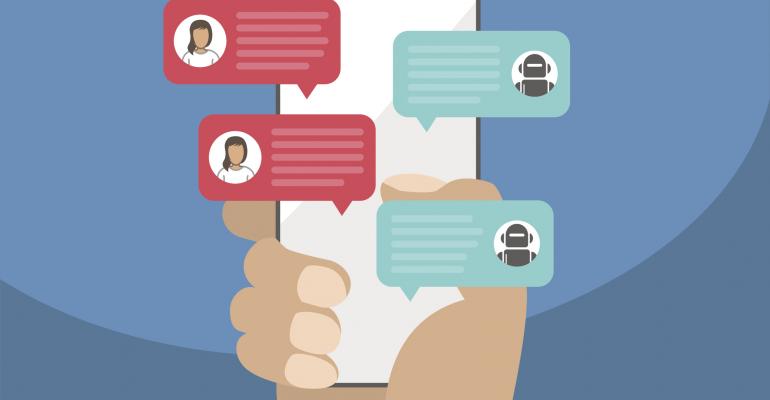Now that digital personal assistants such as Siri, Alexa, and Google Home have begun to fully infiltrate the everyday life of so many potential attendees, is it any wonder that their stripped-down cousin, the chatbot, is starting to gain inroads in events? Not really, said Brandt Krueger, owner of Event Technology Consulting and an instructor at the Event Leadership Institute, during a recent MeetingsNet webinar. Krueger, who has seen his own home become overrun with personal assistants—“They’re really quite invasive as a species”—did have some initial hesitation about event chatbots, but he now finds himself bullish on the technology.
What Are Event Chatbots?
What they’re not is an “all-encompassing form of artificial intelligence that’s being used on a massive server in Google-town,” he said. They won’t control your lights or music like home-based personal assistants, either. Chatbots provide just the core functionality of a personal assistant: Your attendees can ask it a question in everyday language and get an answer in a form they can understand.
Some use standalone SMS (short messaging service, more commonly known as texting). Others live inside messaging apps such as Facebook Messenger or Telegram. Yet others take the form of chat boxes attendees can access through a web-based app, or are embedded in your event app itself, said Krueger. They all focus on providing just one core function: Answering questions.
Resistance Is Futile
But the meetings industry is all about people connecting with people, not robots. How can chatbots possibly be a good idea? “People said the same sorts of things about event apps,” said Krueger. And yet now we’re at a point where an average of 50 percent of attendees are installing and using events apps. “I think we’re going to see the same thing with chatbots,” he said.
Why People Don’t Want to Use Chatbots, But Should
Objection #1: “Who wants to talk with a robot?”
This objection stems from the awful experience pretty much everyone has had with interminable corporate phone trees, where you find yourself pounding zero in the vain hope of reaching an operator that can get you to a human who can actually answer your question. But, says Krueger, “With chatbots, it’s surprisingly fast to get to get an answer.”
In fact, this is one of the main benefits of the technology, he said. You know all those detailed emails you send out pre-conference about where to park, what the dress code is, and how to get from the airport? Yeah, no one reads those, said Krueger.
Chatbots solve that problem with a quick text and reply—something that almost everyone is comfortable with doing these days. You already know what those most-common questions will be, since they’re the same ones you already answer in your pre-con messaging. Chatbots are just another, very convenient, way to let people know where the bus will pick them up for the evening activity.
Think of how much time this could save your staff, as well as your attendees: Krueger said that at IMEX Frankfurt last year, a chatbot answered 3,600 questions—“That’s 3,600 questions that wouldn’t have to be answered by your or your staff.”
Objection #2: What happens if the chatbot doesn’t know the answer to the question?
Again, the specter of a phone tree rises in the back of one’s mind—but unlike a phone tree, if a chatbot doesn’t know the answer, it will automatically kick you up the chain to a live human being. It just saves your staff the time of constantly having to answer those standard FAQs.
Objection #3: Aren’t they going to be expensive? And need a long lead time?
“The companies I spoke with leading up to this webinar were actually very forthcoming about cost, much more so than most tech companies I talk with,” Krueger said. The prices ranged from $20,000 for “a white-glove, very do-everything-for-you experience, down to $1,000 for an entry-level service where you have to do more of the heavy lifting.” Other chatbot providers use a revenue-share model, “So if you have sponsorships or plan to sell ads in the platform, they will give it to you for free and then take a share of what you make.”
Chatbot Best Practices
1. They can’t and shouldn’t replace people.
While chatbots are great for the questions you know will come up, you always want the chatbot to be able to refer a query to a live person as quickly as possible. “Keep people standing by, keep those registration desks staffed, keep those friendly faces strewn throughout your event,” he said. “Chatbots are just another way for people to get information as quickly as possible. Don’t look at this as a way to replace human beings in your event. Use it to augment the support you’re already giving.”
2. Don’t try to pretend your chatbots are people.
“Some of the creepiness with this type of technology is when companies aren’t transparent about it.” Let people know in very clear ways that “Bob the Butler” is a bot so they aren’t expecting it to be more than what it is.
3. Learn from your chatbot.
The fact that the chatbot won’t always know the answer actually can be a hidden benefit: Chatbots can help bring issues to the surface you didn’t know you had. Krueger said that one chatbot company CEO he interviewed said that, during a recent event, the chatbot was getting a lot of questions about where the mother support room was. Oops, they didn’t have one. “They were able to get one set up and ready to go, and then get back to those attendees and say, ‘Here’s where it is,’ as if it had been set up that way all along. It’s an amazing way of discovering problems and getting them taken care of before people know there are problems,” he said.





